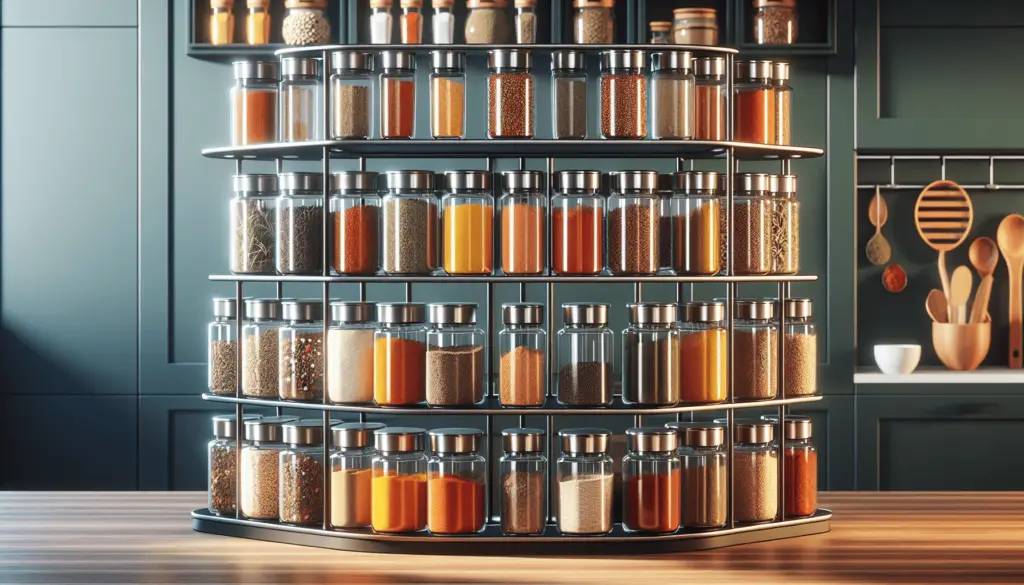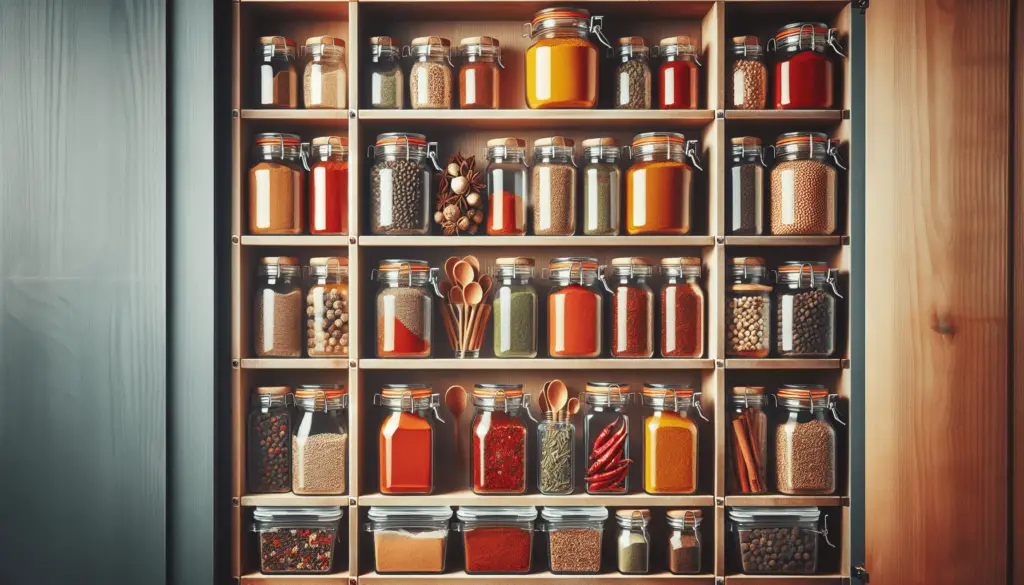Have you ever wondered how to keep your spices fresh and flavorful for longer periods of time? In this article, we will explore the importance of proper spice storage techniques, not only for maintaining the taste of your dishes but also for preserving the health benefits of these natural flavor enhancers. Let’s delve into the world of spice storage in the Prepper’s Pantry and discover how you can optimize the longevity and efficacy of your favorite herbs and spices.
Importance of Proper Spice Storage
Spices are not only a great way to add flavor to your dishes, but they also come with a multitude of health benefits. From aiding digestion to boosting immune function, spices are an essential part of any well-rounded diet. However, improper storage can lead to the degradation of their flavor and potency, reducing their effectiveness in both culinary and medicinal applications.
When you expose spices to light, heat, air, and moisture, they can lose their aroma, flavor, and nutritional value. By storing your spices properly, you can ensure that they remain fresh and potent for longer durations. This not only improves the taste of your dishes but also maximizes the health benefits you can derive from these natural ingredients.
The Impact of Improper Spice Storage
Imagine preparing a delicious meal, only to find that the spices you’ve added have lost their flavor and aroma. Improper spice storage can result in tasteless dishes that lack the depth and complexity that quality spices provide. Additionally, when spices lose their potency, the health benefits they offer diminish, depriving you of valuable nutrients and medicinal properties.
The impact of improper spice storage goes beyond just culinary disappointments. When you invest in high-quality spices, you want to make sure you are getting the most out of them both in terms of flavor and health benefits. By understanding the importance of proper storage techniques, you can optimize the lifespan and effectiveness of your spice collection.
Factors Affecting Spice Storage
Several factors can affect the quality and freshness of your spices. Understanding these factors is essential in developing an effective spice storage strategy that prolongs the shelf life of your herbs and spices.
Light
Light exposure can cause spices to lose their color, flavor, and nutritional value. It’s important to store your spices in a dark place to prevent deterioration due to light exposure. Consider using opaque containers or storing your spices in a dark pantry to protect them from light damage.
When exposed to light, spices such as turmeric, paprika, and chili powder can lose their vibrant colors and bold flavors. By keeping your spices in a dark environment, you can preserve their visual appeal and taste, enhancing the overall presentation and sensory experience of your dishes.
Heat
Heat can accelerate the breakdown of volatile compounds in spices, leading to flavor loss and reduced potency. It’s crucial to store your spices away from heat sources such as stoves, ovens, and direct sunlight. Opt for cool and dry storage spaces to maintain the integrity of your spice collection.
Spices like cumin, coriander, and cinnamon are particularly sensitive to heat and can lose their essential oils and aromatic compounds when exposed to high temperatures. By storing your spices in a cool environment, you can prevent flavor degradation and ensure that they retain their full potential in enhancing your culinary creations.
Air
Oxygen exposure can cause spices to oxidize, resulting in flavor changes and loss of aroma. To protect your spices from air exposure, use airtight containers that seal in freshness and prevent oxidation. Avoid storing spices in open containers or bags that allow air to come into contact with them.
When spices are exposed to air, they are susceptible to oxidation, which can lead to rancidity and off-flavors. By using airtight containers, you can create a protective barrier that preserves the volatile compounds responsible for the unique flavors and aromas of your spices, ensuring their longevity and freshness.
Moisture
Moisture can cause spices to clump together and lose their texture, flavor, and potency. It’s crucial to store spices in a dry environment to prevent moisture absorption and spoilage. Avoid storing spices near the sink, dishwasher, or other sources of humidity to maintain their quality.
Spices like garlic powder, onion powder, and ground ginger are hygroscopic, meaning they absorb moisture from the air and clump up when exposed to humidity. By keeping your spices in a dry location, you can prevent caking and preserve their integrity, allowing you to enjoy their full flavor and aroma in your culinary creations.

Best Practices for Spice Storage
Now that you understand the factors that can impact spice storage, let’s explore some best practices for preserving the flavor and health benefits of your herbs and spices.
Use Airtight Containers
Airtight containers are essential for protecting spices from moisture, air, and light. Opt for containers made of glass, stainless steel, or airtight plastic to create a barrier that preserves the freshness and potency of your spices. Make sure to seal the containers tightly to prevent exposure to external elements that can degrade the quality of your spices.
When you store your spices in airtight containers, you create a protective environment that minimizes oxidation and moisture absorption, keeping your spices flavorful and aromatic for longer periods. By investing in high-quality airtight containers, you can safeguard the integrity of your spice collection and enhance the taste of your dishes.
Store Spices in a Cool, Dry Place
Cool, dry environments are ideal for storing spices as they help maintain the aroma, flavor, and color of these natural ingredients. Choose a dark pantry, cupboard, or drawer away from heat sources and humidity to protect your spices from degradation. Avoid storing spices near the stove, oven, or dishwasher, as these areas can expose them to heat and moisture, compromising their quality.
By storing your spices in a cool, dry location, you can prevent flavor loss and maintain the potency of your herbs and spices. The stable temperature and low humidity of a proper storage space ensure that your spices remain fresh and vibrant, allowing you to enjoy the full spectrum of flavors and aromas they offer in your culinary creations.
Label and Date Your Spice Containers
Labeling and dating your spice containers is a simple yet effective way to keep track of your spice collection and ensure freshness. Write the name of the spice and the date of purchase or expiration on each container to avoid confusion and spoilage. This practice will help you identify and use spices before they lose their flavor and potency, enabling you to maximize their benefits in your cooking.
When you label and date your spice containers, you establish a system that promotes organization and freshness in your pantry. By clearly marking the contents and purchase dates of your spices, you can easily identify and rotate them to maintain their quality and efficacy. This proactive approach ensures that you always have access to flavorful and aromatic spices that elevate the taste of your dishes.
Spice Storage Tips for Specific Spices
Different spices have varying storage requirements due to their unique characteristics and compositions. Let’s explore some specific storage tips for common herbs and spices to help you preserve their flavor and health benefits effectively.
Whole Spices
Whole spices such as cinnamon sticks, peppercorns, and cloves have a longer shelf life than ground spices due to their intact structures. Store whole spices in airtight containers away from heat, light, and moisture to maintain their freshness and potency. Grind whole spices as needed to enhance the flavor and aroma of your dishes.
By storing whole spices in airtight containers, you can prolong their shelf life and retain their essential oils and volatile compounds. The intact structures of whole spices protect them from oxidation and flavor loss, ensuring that you experience the full breadth of their flavors and aromas when you use them in your cooking.
Ground Spices
Ground spices like cumin, paprika, and turmeric are more susceptible to flavor degradation and moisture absorption than whole spices. To preserve the quality of ground spices, store them in airtight containers in a cool, dark place and avoid exposing them to heat and humidity. Check the expiration dates regularly and replace ground spices that have lost their potency.
Ground spices are vulnerable to oxidation and moisture, which can compromise their taste and aroma over time. By storing ground spices in airtight containers in a cool, dark environment, you can shield them from external elements that can reduce their effectiveness. Monitoring the expiration dates of ground spices ensures that you always have fresh and flavorful ingredients to elevate your culinary creations.
Fresh Herbs
Fresh herbs like basil, parsley, and cilantro require special care to maintain their flavor and nutritional value. Store fresh herbs in the refrigerator in airtight containers or wrapped in damp paper towels to prevent wilting and moisture loss. Use fresh herbs within a few days of purchase for optimal taste and aroma.
Fresh herbs are delicate and perishable, requiring immediate refrigeration and moisture to retain their freshness and vibrancy. By storing fresh herbs in airtight containers or wrapped in damp paper towels, you can create a humid environment that prevents wilting and drying. Using fresh herbs promptly ensures that you enjoy the full flavor and nutrient content of these aromatic ingredients in your culinary creations.

Enhancing Your Spice Storage System
Now that you have learned the importance of proper spice storage and the best practices for preserving the flavor and health benefits of your herbs and spices, it’s time to enhance your spice storage system for optimal results.
Inventory Management
Maintaining an organized inventory of your spices helps you keep track of expiration dates, usage frequency, and replenishment needs. Create a spice inventory list with names, purchase dates, and expiration dates to manage your spice collection effectively. Regularly update your inventory and discard expired or low-quality spices to make room for fresh replacements.
By managing your spice inventory systematically, you can streamline your cooking process and ensure that you always have access to high-quality ingredients. Keep track of your spices’ expiration dates and usage patterns to prevent waste and maintain freshness in your pantry. A well-organized inventory allows you to identify and address gaps in your spice collection, enabling you to stock up on essential herbs and spices for your culinary adventures.
Rotation System
Implementing a rotation system for your spice collection helps you use older spices first and prevent them from losing their potency. Label your spice containers with purchase dates and organize them in a way that allows easy access to the oldest spices. Use older spices before newer ones to ensure that you enjoy their full flavor and aroma before they degrade over time.
A rotation system ensures that you prioritize the use of older spices, minimizing waste and maximizing freshness in your pantry. By labeling and organizing your spice containers based on purchase dates, you can easily identify which spices to use first, preventing them from becoming stale or flavorless. This proactive approach to spice rotation enhances the taste and quality of your dishes, allowing you to savor the full range of flavors that your spice collection has to offer.
Conclusion
Spices are not only culinary staples but also valuable sources of flavor and health benefits. By understanding the importance of proper spice storage techniques and implementing best practices for preserving the freshness and potency of your herbs and spices, you can elevate the taste of your dishes and maximize the nutritional value of your meals. Remember to store your spices in airtight containers, in a cool and dry place, away from light, heat, and moisture. Label and date your spice containers to track their freshness and usage, and create a rotation system to prioritize older spices and prevent waste. With a well-maintained spice storage system, you can enjoy the full spectrum of flavors and aromas that quality spices have to offer, enhancing your culinary creations and promoting your overall well-being.
